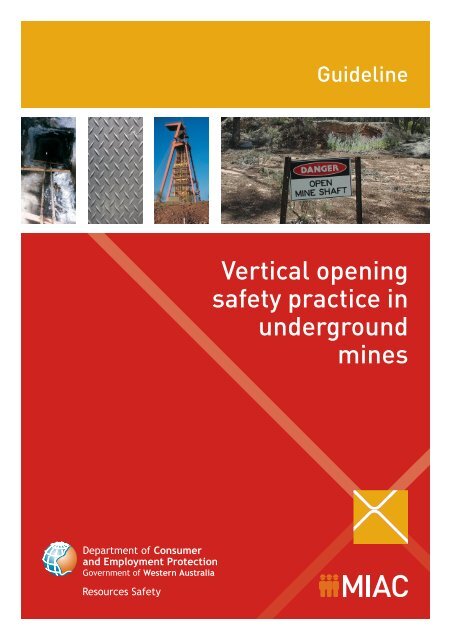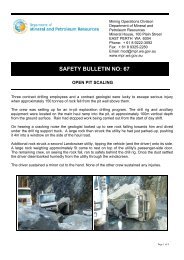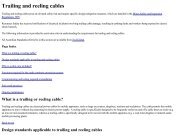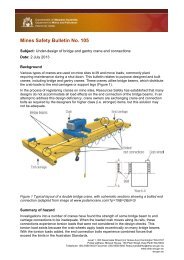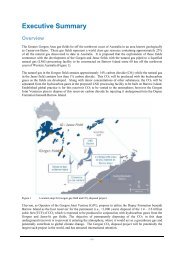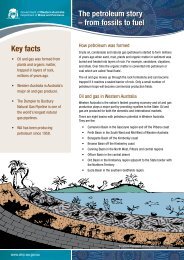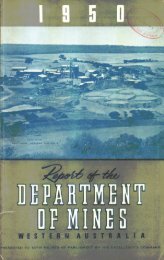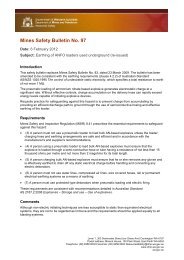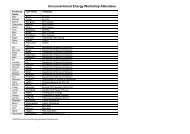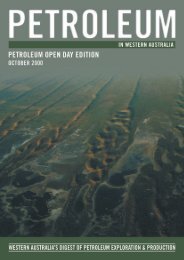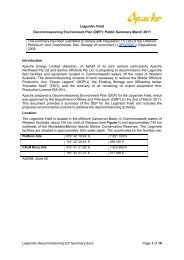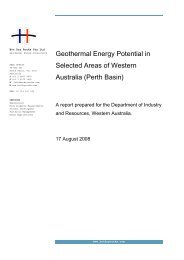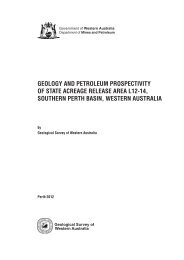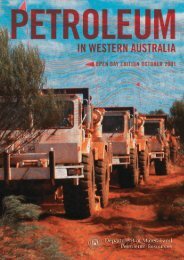Vertical opening safety practice in underground mines - guideline
Vertical opening safety practice in underground mines - guideline
Vertical opening safety practice in underground mines - guideline
You also want an ePaper? Increase the reach of your titles
YUMPU automatically turns print PDFs into web optimized ePapers that Google loves.
Guidel<strong>in</strong>e<br />
<strong>Vertical</strong> <strong>open<strong>in</strong>g</strong><br />
<strong>safety</strong> <strong>practice</strong> <strong>in</strong><br />
<strong>underground</strong><br />
m<strong>in</strong>es
Guidel<strong>in</strong>e<br />
<strong>Vertical</strong> <strong>open<strong>in</strong>g</strong><br />
<strong>safety</strong> <strong>practice</strong><br />
<strong>in</strong> <strong>underground</strong><br />
m<strong>in</strong>es
Disclaimer<br />
The <strong>in</strong>formation conta<strong>in</strong>ed <strong>in</strong><br />
this publication is provided <strong>in</strong><br />
good faith and believed to be<br />
reliable and accurate at the<br />
time of publication. However,<br />
the <strong>in</strong>formation is provided<br />
on the basis that the reader<br />
will be solely responsible for<br />
assess<strong>in</strong>g the <strong>in</strong>formation and<br />
its veracity and usefulness.<br />
The State shall <strong>in</strong> no way<br />
be liable, <strong>in</strong> negligence or<br />
howsoever, for any loss<br />
susta<strong>in</strong>ed or <strong>in</strong>curred<br />
by anyone rely<strong>in</strong>g on the<br />
<strong>in</strong>formation, even if such<br />
<strong>in</strong>formation is or turns out to<br />
be wrong, <strong>in</strong>complete, out-ofdate<br />
or mislead<strong>in</strong>g.<br />
In this disclaimer:<br />
State means the State of<br />
Western Australia and <strong>in</strong>cludes<br />
every M<strong>in</strong>ister, agent, agency,<br />
department, statutory body<br />
corporate and <strong>in</strong>strumentality<br />
thereof and each employee or<br />
agent of any of them.<br />
Information <strong>in</strong>cludes<br />
<strong>in</strong>formation, data,<br />
representations, advice,<br />
statements and op<strong>in</strong>ions,<br />
expressly or implied set out <strong>in</strong><br />
this publication.<br />
Loss <strong>in</strong>cludes loss, damage,<br />
liability, cost, expense, illness<br />
and <strong>in</strong>jury (<strong>in</strong>clud<strong>in</strong>g death).<br />
Reference<br />
The recommended reference for this publication is:<br />
Department of Consumer and Employment Protection, 2008, <strong>Vertical</strong><br />
Open<strong>in</strong>g Safety Practice <strong>in</strong> Underground M<strong>in</strong>es — guidel<strong>in</strong>e: Resources<br />
Safety, Department of Consumer and Employment Protection, Western<br />
Australia, 15 pp.<br />
ISBN 978 1 921163 23 4<br />
First published <strong>in</strong> 2005 by the Department of Industry and Resources.<br />
Second edition 2008.<br />
© Department of Consumer and Employment Protection, 2008.<br />
Except where the Copyright Act otherwise allows, reproduction <strong>in</strong> whole<br />
or part of this publication will be permitted only with the prior written<br />
permission of the Department of Consumer and Employment Protection.<br />
Applications for permission should be addressed to the Publications and<br />
Promotions Manager, Resources Safety.<br />
This publication is available on request <strong>in</strong> other formats for people with<br />
special needs<br />
This publication is also available <strong>in</strong> digital format (PDF) onl<strong>in</strong>e at<br />
www.docep.wa.gov.au/ResourcesSafety<br />
Further details of publications produced by Resources Safety can be obta<strong>in</strong>ed<br />
by contact<strong>in</strong>g:<br />
Resources Safety<br />
Department of Consumer and Employment Protection<br />
Locked Bag 14<br />
CLOISTERS SQUARE WA 6850<br />
General queries<br />
Telephone: +61 8 9358 8002<br />
NRS: 13 36 77<br />
Facsimile: +61 8 9358 8188<br />
Email: ResourcesSafety@docep.wa.gov.au<br />
For publication orders<br />
Telephone: +61 8 9358 8154<br />
Email: RSDComms@docep.wa.gov.au<br />
4 ii<br />
<strong>Vertical</strong> <strong>open<strong>in</strong>g</strong> <strong>safety</strong> <strong>practice</strong> <strong>in</strong> <strong>underground</strong> m<strong>in</strong>es — guidel<strong>in</strong>e
Contents<br />
Foreword ......................................................................... iv<br />
1 Introduction ...............................................................1<br />
2 Risk statement...........................................................1<br />
3 Nature of the hazard ..................................................1<br />
4 Approach to vertical <strong>open<strong>in</strong>g</strong> <strong>safety</strong> <strong>practice</strong> .............2<br />
5 Develop<strong>in</strong>g a system of vertical<br />
<strong>open<strong>in</strong>g</strong> procedures ...................................................2<br />
6 Procedure for ore passes ...........................................2<br />
7 Procedure for open stopes .........................................6<br />
8 Procedure for ladderways .........................................7<br />
9 Procedure for chang<strong>in</strong>g raisebore drillheads<br />
or cutters ..................................................................9<br />
10 Further <strong>in</strong>formation ...................................................9<br />
Appendix A — Legislative requirements for<br />
vertical <strong>open<strong>in</strong>g</strong> <strong>safety</strong> <strong>practice</strong> ......................................10<br />
Appendix B — Legislative requirements for<br />
ore passes ......................................................................14<br />
Appendix C — Legislative requirements for<br />
ladderways .....................................................................15<br />
Resources Safety, Department Consumer and Employment Protection iii<br />
5
GuiDel<strong>in</strong>es<br />
A guidel<strong>in</strong>e is an<br />
explanatory document<br />
that provides more<br />
<strong>in</strong>formation on the<br />
requirements of<br />
legislation, details<br />
good <strong>practice</strong>, and<br />
may expla<strong>in</strong> means<br />
of compliance with<br />
standards prescribed<br />
<strong>in</strong> the legislation. The<br />
government, unions or<br />
employer groups may<br />
issue guidance material.<br />
Compliance with<br />
guidel<strong>in</strong>es is not<br />
mandatory but they could<br />
have legal stand<strong>in</strong>g if<br />
it were demonstrated<br />
that the guidel<strong>in</strong>e is the<br />
<strong>in</strong>dustry norm.<br />
Who shoulD use<br />
this GuiDel<strong>in</strong>e?<br />
This guidel<strong>in</strong>e should<br />
be used by everyone<br />
work<strong>in</strong>g near or <strong>in</strong><br />
vertical or subvertical<br />
<strong>open<strong>in</strong>g</strong>s <strong>in</strong> <strong>underground</strong><br />
m<strong>in</strong>es, or responsible for<br />
such personnel.<br />
Foreword<br />
This guidel<strong>in</strong>e is issued by Resources Safety under the<br />
M<strong>in</strong>es Safety and Inspection Act 1994, and has been endorsed<br />
by the M<strong>in</strong><strong>in</strong>g Industry Advisory Committee.<br />
The Act<br />
The M<strong>in</strong>es Safety and Inspection Act 1994 (the Act) sets<br />
objectives to promote and improve occupational <strong>safety</strong> and<br />
health standards with<strong>in</strong> the m<strong>in</strong>erals <strong>in</strong>dustry.<br />
The Act sets out broad duties, and is supported by<br />
regulations, together with codes of <strong>practice</strong> and guidel<strong>in</strong>es.<br />
Regulations<br />
The M<strong>in</strong>es Safety and Inspection Regulations 1995 (the<br />
regulations) provide more specific requirements for a range<br />
of activities. Like the Act, regulations are enforceable and<br />
breaches may result <strong>in</strong> prosecution, f<strong>in</strong>es, or directions to<br />
cease operations and undertake remedial action.<br />
Application<br />
The provisions of this guidel<strong>in</strong>e apply to all m<strong>in</strong>es as def<strong>in</strong>ed <strong>in</strong><br />
section 4(1) of the Act.<br />
6 iv<br />
<strong>Vertical</strong> <strong>open<strong>in</strong>g</strong> <strong>safety</strong> <strong>practice</strong> <strong>in</strong> <strong>underground</strong> m<strong>in</strong>es — guidel<strong>in</strong>e
1 <strong>in</strong>troduction<br />
The purpose of this guidel<strong>in</strong>e is to emphasise the<br />
nature of some of the more obvious hazards associated<br />
with vertical <strong>open<strong>in</strong>g</strong>s, and to recommend a system of<br />
procedures to avoid or m<strong>in</strong>imise the risks associated<br />
with them.<br />
2 Risk statement<br />
All m<strong>in</strong>es to which this guidel<strong>in</strong>e applies should be<br />
able to demonstrate that the hazards associated with<br />
vertical <strong>open<strong>in</strong>g</strong>s are be<strong>in</strong>g effectively managed. Risk<br />
management is essential to prevent fatalities and <strong>in</strong>juries.<br />
It <strong>in</strong>cludes:<br />
• spott<strong>in</strong>g the hazards<br />
• assess<strong>in</strong>g the risks<br />
• mak<strong>in</strong>g the changes necessary to elim<strong>in</strong>ate the<br />
hazard or m<strong>in</strong>imise the risk of <strong>in</strong>jury or harm<br />
to health.<br />
3 nature of the hazard<br />
<strong>Vertical</strong> <strong>open<strong>in</strong>g</strong>s with<strong>in</strong> <strong>underground</strong> m<strong>in</strong>es present a<br />
range of potentially serious hazards, usually due to space<br />
and visibility constra<strong>in</strong>ts.<br />
It is essential that all personnel are made fully aware of<br />
these hazards at <strong>in</strong>duction, and that they are regularly<br />
given rem<strong>in</strong>ders, particularly when there are new<br />
developments or when operat<strong>in</strong>g procedures are changed<br />
or revised.<br />
Issues relat<strong>in</strong>g to “old” <strong>underground</strong> <strong>open<strong>in</strong>g</strong>s exposed<br />
dur<strong>in</strong>g openpit m<strong>in</strong><strong>in</strong>g are addressed <strong>in</strong> a guidel<strong>in</strong>e on<br />
openpit m<strong>in</strong><strong>in</strong>g through <strong>underground</strong> work<strong>in</strong>gs<br />
(DoIR, 2000).<br />
The M<strong>in</strong>es Safety and Inspection Regulations 1995 conta<strong>in</strong><br />
regulations that cover aspects relat<strong>in</strong>g to vertical <strong>open<strong>in</strong>g</strong>s<br />
(see Appendices A, B and C).<br />
Resources Safety, Department Consumer and Employment Protection 1
4 Approach to vertical <strong>open<strong>in</strong>g</strong><br />
<strong>safety</strong> <strong>practice</strong><br />
The design of vertical <strong>open<strong>in</strong>g</strong>s <strong>underground</strong> must ensure<br />
that effective <strong>safety</strong> precautions can be readily applied.<br />
It is particularly important <strong>in</strong> the case of sublevel open<br />
stopes, or other stop<strong>in</strong>g systems where there could be<br />
access to vertical <strong>open<strong>in</strong>g</strong>s at a number of horizons, that<br />
well-established vertical <strong>open<strong>in</strong>g</strong> procedures are clearly<br />
promulgated and rigidly adhered to.<br />
5 Develop<strong>in</strong>g a system of vertical<br />
<strong>open<strong>in</strong>g</strong> procedures<br />
Safe vertical <strong>open<strong>in</strong>g</strong> procedures must be devised and<br />
implemented <strong>in</strong> <strong>underground</strong> m<strong>in</strong>es where operations at two or<br />
more horizons are l<strong>in</strong>ked by vertical or subvertical <strong>open<strong>in</strong>g</strong>s.<br />
Such procedures must be approved by the registered m<strong>in</strong>e<br />
manager and will carry the authority of the M<strong>in</strong>es Safety<br />
and Inspection Regulations 1995 if there is deviation from<br />
the approved procedures.<br />
This system must apply to all personnel, <strong>in</strong>clud<strong>in</strong>g survey,<br />
geological and rock mechanics staff, work<strong>in</strong>g near or <strong>in</strong><br />
vertical or subvertical <strong>open<strong>in</strong>g</strong>s.<br />
6 Procedure for ore passes<br />
6.1 Location of passes<br />
Some recommendations <strong>in</strong> this section refer to<br />
m<strong>in</strong><strong>in</strong>g techniques that are becom<strong>in</strong>g less common.<br />
However, those techniques are still be<strong>in</strong>g used and the<br />
recommendations rema<strong>in</strong> relevant.<br />
Any access to the top of a pass or any other horizon that<br />
allows tipp<strong>in</strong>g <strong>in</strong>to a pass (via a f<strong>in</strong>ger rise <strong>in</strong> the case of<br />
multilevel use of the pass) should be of an adequate length<br />
off the tramm<strong>in</strong>g level or decl<strong>in</strong>e. The length depends on<br />
the size of development head<strong>in</strong>gs and equipment used, but<br />
will typically be <strong>in</strong> the range from 5 to 16 m.<br />
2 <strong>Vertical</strong> <strong>open<strong>in</strong>g</strong> <strong>safety</strong> <strong>practice</strong> <strong>in</strong> <strong>underground</strong> m<strong>in</strong>es — guidel<strong>in</strong>e
Locat<strong>in</strong>g the tip po<strong>in</strong>t off the tramm<strong>in</strong>g or haulage way <strong>in</strong><br />
this fashion:<br />
• provides clearance of the vehicle to pass<strong>in</strong>g traffic while<br />
tipp<strong>in</strong>g<br />
• m<strong>in</strong>imises the risk, to personnel at a lower horizon,<br />
result<strong>in</strong>g from spillage fall<strong>in</strong>g <strong>in</strong>to the pass from pass<strong>in</strong>g<br />
vehicles<br />
• facilitates the control (e.g. us<strong>in</strong>g sprays and flaps) of dust<br />
emitted from the pass as a result of tipp<strong>in</strong>g at other horizons.<br />
There should be provision for the straightforward fitt<strong>in</strong>g of<br />
appropriate barricad<strong>in</strong>g and signage, <strong>in</strong>clud<strong>in</strong>g reflective<br />
signs and battery-operated traffic-type flash<strong>in</strong>g lights.<br />
A stop log (block) or other suitable secure structure should<br />
be placed at every tipp<strong>in</strong>g po<strong>in</strong>t.<br />
Figure 1 illustrates these po<strong>in</strong>ts with respect to passes.<br />
Where the location of a pass adjacent to a drive or travelway<br />
is unavoidable (e.g. due to previous m<strong>in</strong>e design or exist<strong>in</strong>g<br />
development constra<strong>in</strong>ts), the pass must be protected<br />
by a raised concrete parapet or other effective barrier.<br />
Where there is any danger of personnel or spillage from<br />
pass<strong>in</strong>g vehicles fall<strong>in</strong>g <strong>in</strong>to such a pass, a steel or timber<br />
cover operated by mechanical means (e.g. air or hydraulic<br />
cyl<strong>in</strong>der, rope, pulley) must be provided.<br />
The tipp<strong>in</strong>g po<strong>in</strong>t <strong>in</strong>to any pass must be provided with adequate<br />
warn<strong>in</strong>gs to prevent <strong>in</strong>advertent entry. Reflective signs, tape,<br />
or securely fastened <strong>safety</strong> mesh are required, <strong>in</strong> addition to a<br />
requirement to securely barricade the access when not <strong>in</strong> use.<br />
Where passes are pulled or extracted at drawpo<strong>in</strong>ts, millholes<br />
or grizzlies, the design and brow configuration must be such<br />
that persons pass<strong>in</strong>g through the area or work<strong>in</strong>g on extraction<br />
are not at risk from uncontrolled fall or discharge of rock.<br />
6.2 Operation of passes<br />
The legislative requirements applicable to ore passes are<br />
given <strong>in</strong> Appendix B.<br />
Given that the ore pass system must be designed to suit the<br />
nature and scale of the m<strong>in</strong><strong>in</strong>g method, it is essential that<br />
proper operat<strong>in</strong>g control is exercised on the material tipped <strong>in</strong>to<br />
the pass. Excessive oversize creates hang-ups, and the br<strong>in</strong>g<strong>in</strong>g<br />
Resources Safety, Department Consumer and Employment Protection 3<br />
KeY Po<strong>in</strong>ts —<br />
oRe PAsses<br />
• The chute, drawpo<strong>in</strong>t,<br />
cha<strong>in</strong> control or other<br />
extraction system on<br />
the pass must be locked<br />
out, barricaded and<br />
signposted to prevent<br />
<strong>in</strong>advertent drawdown.<br />
• Where feasible, a stag<strong>in</strong>g<br />
should be constructed<br />
that is supported<br />
<strong>in</strong>dependent of the loose<br />
rock <strong>in</strong> the pass.<br />
• Properly rigged <strong>safety</strong> belts<br />
or harnesses, preferably<br />
with <strong>in</strong>ertia reels, must<br />
be provided for anyone<br />
work<strong>in</strong>g on a grizzly.
Section A<br />
Safety cha<strong>in</strong> with<br />
warn<strong>in</strong>g sign<br />
Figure 1: Ore pass layout<br />
F<strong>in</strong>ger rise<br />
(do not fill<br />
past this po<strong>in</strong>t)<br />
Water spray<br />
Safety stop<br />
5–16 m<br />
Dust curta<strong>in</strong><br />
Water spray<br />
Safety stop<br />
down of hung passes by blast<strong>in</strong>g or other means <strong>in</strong>troduces<br />
additional hazards that should be elim<strong>in</strong>ated where possible.<br />
The addition of water to the top of passes to br<strong>in</strong>g down<br />
hang-ups can result <strong>in</strong> the accumulation of water <strong>in</strong> the<br />
pass, above the hang-up. This can create an extremely<br />
hazardous situation, and catastrophic accidents have<br />
resulted from what is called a mud-rush. The use of water<br />
<strong>in</strong> this fashion must be strictly controlled and only carried<br />
out under the direction of <strong>in</strong>formed and experienced people<br />
with the approval of the registered m<strong>in</strong>e manager.<br />
4 <strong>Vertical</strong> <strong>open<strong>in</strong>g</strong> <strong>safety</strong> <strong>practice</strong> <strong>in</strong> <strong>underground</strong> m<strong>in</strong>es — guidel<strong>in</strong>e<br />
A<br />
A<br />
A<br />
A
When blast<strong>in</strong>g is essential to br<strong>in</strong>g down any pass, meticulous<br />
care must be taken after the hang-up is accurately identified<br />
to warn and protect all persons who may be work<strong>in</strong>g adjacent<br />
to the pass on any horizon to which it connects, and at the<br />
extraction po<strong>in</strong>t if the charge is to be fired from any horizon<br />
above it. The size of such charges should be strictly limited, as<br />
determ<strong>in</strong>ed by the <strong>underground</strong> manager or his or her delegate.<br />
Where f<strong>in</strong>ger rises are used to provide tipp<strong>in</strong>g po<strong>in</strong>ts from<br />
a number of levels or sublevels to a common ore pass, the<br />
f<strong>in</strong>ger rise itself should not be filled. That is, if the ma<strong>in</strong><br />
pass is filled above the f<strong>in</strong>ger rise junction, then tipp<strong>in</strong>g <strong>in</strong>to<br />
the f<strong>in</strong>ger rise should cease. This provision is only effective<br />
if a dependable, accurate means of establish<strong>in</strong>g the level of<br />
material <strong>in</strong> the ore pass is available.<br />
Experience has shown that fill<strong>in</strong>g of f<strong>in</strong>ger passes is a<br />
major cause of hang-ups, and hazards have been created <strong>in</strong><br />
br<strong>in</strong>g<strong>in</strong>g them down.<br />
When a grizzly is <strong>in</strong>stalled on a pass, provision of a <strong>safety</strong><br />
belt, preferably the <strong>in</strong>ertia reel type (e.g. Sala block), is<br />
essential to ensure the <strong>safety</strong> of any person who works<br />
on the grizzly. This equipment must be properly <strong>in</strong>stalled,<br />
<strong>in</strong>spected and ma<strong>in</strong>ta<strong>in</strong>ed, and <strong>in</strong>ertia reels checked<br />
regularly by a competent person.<br />
Resources Safety, Department Consumer and Employment Protection 5<br />
Bulkhead and signage isolat<strong>in</strong>g a<br />
disused ore pass
Where ore passes have a number of f<strong>in</strong>gers, those not<br />
<strong>in</strong> use should be scaled down, blown off and a bulkhead<br />
constructed, and this action recorded. Signs should be<br />
attached to the bulkhead <strong>in</strong>dicat<strong>in</strong>g the nature of the<br />
excavation that has thus been secured.<br />
When ore passes (or any vertical <strong>open<strong>in</strong>g</strong>) are to be closed<br />
off, whether on a temporary or a permanent basis, details<br />
of the status of the pass or <strong>open<strong>in</strong>g</strong> must be recorded on<br />
m<strong>in</strong>e plans and written records.<br />
6.3 Work<strong>in</strong>g <strong>in</strong> or near passes<br />
No-one should move onto or stand on broken rock <strong>in</strong> any<br />
ore pass, nor attempt to do any work <strong>in</strong> such a position until<br />
appropriate <strong>safety</strong> precautions have been taken.<br />
A check should be made to determ<strong>in</strong>e whether there is<br />
any possibility of a hang-up <strong>in</strong> the pass, which could result<br />
<strong>in</strong> a void <strong>in</strong> the pass below the work<strong>in</strong>g horizon that could<br />
suddenly collapse.<br />
Material fall<strong>in</strong>g through an ore pass can entra<strong>in</strong> air<br />
as it travels by any <strong>open<strong>in</strong>g</strong>s <strong>in</strong>to the pass. There are<br />
many recorded <strong>in</strong>stances of people be<strong>in</strong>g drawn <strong>in</strong>to the<br />
excavation through such <strong>open<strong>in</strong>g</strong>s. Where the potential<br />
for this hazard to arise has been identified, suitable<br />
barricades (e.g. air-grat<strong>in</strong>g, heavy gauge mesh) should<br />
be <strong>in</strong>stalled securely and appropriate warn<strong>in</strong>g signs<br />
provided.<br />
If work is required with<strong>in</strong> a pass, a safe means of entry<br />
from the top must be provided, and the whole of the<br />
pass made safe down to the work<strong>in</strong>g area. Suitable<br />
overhead protection must be provided, signs posted,<br />
and effective communication provided to a responsible<br />
person, who will rema<strong>in</strong> at the top of the pass for the<br />
duration of the work.<br />
7 Procedure for open stopes<br />
No-one should ever throw material <strong>in</strong>to open stopes,<br />
except where waste rock, scrap metal or steel pipe is<br />
be<strong>in</strong>g disposed of <strong>in</strong> a completed stope prior to fill<strong>in</strong>g.<br />
Such work must be supervised and only carried out after<br />
a clearance procedure has been followed. No organic or<br />
6 <strong>Vertical</strong> <strong>open<strong>in</strong>g</strong> <strong>safety</strong> <strong>practice</strong> <strong>in</strong> <strong>underground</strong> m<strong>in</strong>es — guidel<strong>in</strong>e
combustible material should be disposed of <strong>in</strong> a stope,<br />
except <strong>in</strong> a stope that is to be tight filled with hydraulically<br />
placed sand or tail<strong>in</strong>gs. Where the disposal of such<br />
materials <strong>in</strong> this way is contemplated, a risk assessment<br />
should be carried out to address any possible adverse<br />
outcome from this activity.<br />
Any person who is to work closer than 10 m from the edge<br />
of a stope (other than the m<strong>in</strong>er or r<strong>in</strong>g blast<strong>in</strong>g crew who<br />
normally operate <strong>in</strong> the stope and the extraction horizon<br />
crew) should only do so accord<strong>in</strong>g to an established vertical<br />
<strong>open<strong>in</strong>g</strong> procedure.<br />
Precautions must be taken to protect r<strong>in</strong>g blast<strong>in</strong>g crews<br />
charg<strong>in</strong>g r<strong>in</strong>gs <strong>in</strong> open stopes. When the brow has been<br />
overpulled at stope drawpo<strong>in</strong>ts, the brow should be closed<br />
by br<strong>in</strong>g<strong>in</strong>g down the rill, or other measures taken to<br />
provide protection. If there is any <strong>open<strong>in</strong>g</strong> at the brow dur<strong>in</strong>g<br />
charg<strong>in</strong>g, all stope accesses above should be barricaded<br />
to prevent <strong>in</strong>advertent entry and “Danger — Men Work<strong>in</strong>g<br />
Below” signs must be <strong>in</strong>stalled.<br />
Similar precautions are required for any rock bolt<strong>in</strong>g or<br />
service crew work<strong>in</strong>g <strong>in</strong> a drawpo<strong>in</strong>t. Such work should<br />
normally be done when the brow is choked, except where<br />
it must be done immediately for the security of persons<br />
required to work <strong>in</strong> the area.<br />
No muck<strong>in</strong>g unit should be allowed to tip or push any<br />
material <strong>in</strong>to an open stope without the permission of<br />
the <strong>underground</strong> manager, and then only as part of a<br />
prearranged, approved operation.<br />
Appropriate barricades must be erected at any place where<br />
ore can rill accidentally <strong>in</strong>to a stope.<br />
8 Procedure for ladderways<br />
It is essential that all ladderways are constructed and<br />
ma<strong>in</strong>ta<strong>in</strong>ed to a safe standard (Appendix C).<br />
The top of any permanently established ladderway<br />
between levels or part of an escape route must be<br />
properly constructed and decked to prevent any<br />
material be<strong>in</strong>g <strong>in</strong>advertently dropped or dislodged <strong>in</strong>to<br />
the raise below.<br />
Resources Safety, Department Consumer and Employment Protection 7<br />
KeY Po<strong>in</strong>ts —<br />
oPen stoPes<br />
• No material should be<br />
thrown <strong>in</strong>to open stopes,<br />
except where waste rock,<br />
scrap metal or steel<br />
pipe is be<strong>in</strong>g disposed of<br />
under supervision prior<br />
to fill<strong>in</strong>g.<br />
• Precautions must be<br />
taken to protect r<strong>in</strong>g<br />
blast<strong>in</strong>g crews charg<strong>in</strong>g<br />
r<strong>in</strong>gs <strong>in</strong> open stopes.<br />
• Precautions must be<br />
taken for any rock bolt<strong>in</strong>g<br />
or service crew work<strong>in</strong>g<br />
<strong>in</strong> the drawpo<strong>in</strong>t.<br />
• No muck<strong>in</strong>g unit should<br />
tip or push ore <strong>in</strong>to an<br />
open stope without<br />
permission.
KeY Po<strong>in</strong>ts —<br />
lADDeRWAYs<br />
• All ladderways are to<br />
be constructed and<br />
ma<strong>in</strong>ta<strong>in</strong>ed to a safe<br />
standard.<br />
• Adequate clearance must<br />
be provided for persons<br />
us<strong>in</strong>g the ladderway.<br />
• No material must be<br />
dropped down any<br />
ladderway or raised or<br />
lowered <strong>in</strong> the ladderway<br />
while any person is us<strong>in</strong>g it.<br />
• Both hands must be<br />
free when climb<strong>in</strong>g or<br />
descend<strong>in</strong>g ladders.<br />
• Every access area on a<br />
ladderway must have a<br />
safe means of enter<strong>in</strong>g<br />
and exit<strong>in</strong>g.<br />
Ladderways must be constructed and<br />
ma<strong>in</strong>ta<strong>in</strong>ed to a safe standard<br />
There must be adequate clearance from pipes, cables or<br />
other services for people us<strong>in</strong>g ladderways.<br />
Appropriate measures must be taken to ensure that no<br />
material can be dropped down any ladderway.<br />
No material should be raised or lowered <strong>in</strong> the ladderway<br />
while any person is us<strong>in</strong>g it.<br />
Both hands must be free when climb<strong>in</strong>g or descend<strong>in</strong>g<br />
on ladders. Any load slung on the back and shoulders<br />
must be secured safely, and not be of such bulk or weight<br />
as to present a risk of fall<strong>in</strong>g. Heavy or bulky loads must<br />
be hoisted. Where a ladderway is equipped with a slide<br />
for land<strong>in</strong>g materials with a w<strong>in</strong>ch or by a hand rope, no<br />
person may travel <strong>in</strong> the ladderway dur<strong>in</strong>g the haulage of<br />
material.<br />
Every ladderway must afford a safe means of enter<strong>in</strong>g and<br />
exit<strong>in</strong>g at any sublevel to which it gives access, as well as<br />
the top and bottom entry. Access ladderways to stopes<br />
must also have protection or a cover<strong>in</strong>g, readily removable<br />
for the transfer of equipment, to prevent people work<strong>in</strong>g <strong>in</strong><br />
the stope fall<strong>in</strong>g <strong>in</strong>to the ladderway.<br />
8 <strong>Vertical</strong> <strong>open<strong>in</strong>g</strong> <strong>safety</strong> <strong>practice</strong> <strong>in</strong> <strong>underground</strong> m<strong>in</strong>es — guidel<strong>in</strong>e
9 Procedure for chang<strong>in</strong>g raisebore<br />
drillheads or cutters<br />
When a raisebore drillhead is lowered to the bottom of the<br />
rise to change the cutters or remove the head, the crew<br />
should be adequately protected ag<strong>in</strong>st the possibility of<br />
rockfall. This protection may consist of a canopy secured<br />
to the drillstr<strong>in</strong>g or a shaft-clos<strong>in</strong>g bladder designed to fit<br />
around the drillstr<strong>in</strong>g.<br />
No water should be allowed to dra<strong>in</strong> <strong>in</strong>to the raise from the<br />
drill chamber dur<strong>in</strong>g such activity.<br />
The New South Wales Department of Primary Industries<br />
has published a comprehensive treatment of raisebore<br />
<strong>safety</strong> (NSW DPI, 2003).<br />
10 Further <strong>in</strong>formation<br />
DEPARTMENT OF INDUSTRy AND RESOURCES, 2000, Open<br />
pit m<strong>in</strong><strong>in</strong>g through <strong>underground</strong> work<strong>in</strong>gs — guidel<strong>in</strong>e:<br />
Safety, Health and Environment Division, Department of<br />
Industry and Resources, Western Australia, 16 pp. Available<br />
at ww.docep.wa.gov.au/ResourcesSafety<br />
NSW DEPARTMENT OF PRIMARy INDUSTRIES, 2003,<br />
Guidel<strong>in</strong>e for raisebor<strong>in</strong>g operations: M<strong>in</strong>eral Resources,<br />
NSW Department of Primary Industries, M<strong>in</strong><strong>in</strong>g Design<br />
Guidel<strong>in</strong>e MDG 1030, 12 pp.<br />
Resources Safety, Department Consumer and Employment Protection 9<br />
KeY Po<strong>in</strong>ts —<br />
ChAnG<strong>in</strong>G RAiseBoRe<br />
DRillheADs oR<br />
CutteRs<br />
• Crews must be protected<br />
aga<strong>in</strong>st rock fall when<br />
a raisebore drillhead is<br />
be<strong>in</strong>g lowered.<br />
• Water must be stopped<br />
from dra<strong>in</strong><strong>in</strong>g <strong>in</strong>to the<br />
raise when cutters<br />
are be<strong>in</strong>g changed or<br />
drillheads removed.
Appendix A — legislative<br />
requirements for vertical <strong>open<strong>in</strong>g</strong><br />
<strong>safety</strong> <strong>practice</strong><br />
M<strong>in</strong>es Safety and Inspection Regulations 1995<br />
Fall arrest equipment<br />
4.5. (1) The manager of, and each employer at, a m<strong>in</strong>e<br />
must ensure that —<br />
(a) fall arrest equipment is provided to employees<br />
at a workplace if the risk of <strong>in</strong>jury to<br />
employees from fall<strong>in</strong>g cannot be elim<strong>in</strong>ated<br />
from the workplace or the system of work at<br />
the workplace; and<br />
(b) the equipment referred to <strong>in</strong> paragraph (a) is —<br />
(i) appropriately designed for the task for<br />
which it is to be used;<br />
(ii) used <strong>in</strong> such a way as to reduce, so far as<br />
is practicable, the possibility of <strong>in</strong>jury to<br />
the user; and<br />
(iii) properly ma<strong>in</strong>ta<strong>in</strong>ed.<br />
Penalty: See regulation 17.1.<br />
(2) If any fall arrest equipment is used to arrest a<br />
fall, the manager and each employer must ensure<br />
that the equipment is checked by a competent<br />
person and is serviced or discarded <strong>in</strong> accordance<br />
with the manufacturer’s specifications.<br />
Penalty: See regulation 17.1.<br />
Shaft entrances to be fenced<br />
10.17. (1) The manager of an <strong>underground</strong> m<strong>in</strong>e must<br />
ensure that the top and each level entrance to<br />
a shaft <strong>in</strong> the m<strong>in</strong>e is kept securely fenced or<br />
protected by a gate.<br />
Penalty: See regulation 17.1.<br />
(2) Subregulation (1) does not prevent the temporary<br />
removal of a fence or gate for the purposes<br />
of repairs or other operations if other proper<br />
10 <strong>Vertical</strong> <strong>open<strong>in</strong>g</strong> <strong>safety</strong> <strong>practice</strong> <strong>in</strong> <strong>underground</strong> m<strong>in</strong>es — guidel<strong>in</strong>e
precautions are taken to protect the entrance to<br />
the shaft.<br />
W<strong>in</strong>ze s<strong>in</strong>k<strong>in</strong>g operations<br />
10.20. (1) The manager of an <strong>underground</strong> m<strong>in</strong>e must<br />
ensure that, so far as is practicable, each w<strong>in</strong>ze<br />
sunk at the m<strong>in</strong>e is clear of a travell<strong>in</strong>g way.<br />
Penalty: See regulation 17.1.<br />
(2) The manager of an <strong>underground</strong> m<strong>in</strong>e must<br />
ensure that the brace of each w<strong>in</strong>ze at the m<strong>in</strong>e is<br />
constructed <strong>in</strong> a way that will prevent loose rock or<br />
material from accidentally fall<strong>in</strong>g down the w<strong>in</strong>ze.<br />
Penalty: See regulation 17.1.<br />
(3) The manager of an <strong>underground</strong> m<strong>in</strong>e must<br />
ensure that a signall<strong>in</strong>g system is <strong>in</strong>stalled <strong>in</strong> a<br />
w<strong>in</strong>ze if depth, ambient noise or other factors <strong>in</strong><br />
the w<strong>in</strong>ze make verbal communication difficult or<br />
<strong>in</strong>effective.<br />
Penalty: See regulation 17.1.<br />
(4) The manager of an <strong>underground</strong> m<strong>in</strong>e must ensure<br />
that if hoist<strong>in</strong>g appliances are utilized <strong>in</strong> a w<strong>in</strong>ze<br />
at the m<strong>in</strong>e, a knocker l<strong>in</strong>e or other contrivance<br />
approved by the district <strong>in</strong>spector is provided <strong>in</strong> the<br />
w<strong>in</strong>ze to enable signals to be communicated to the<br />
driver from each part of the w<strong>in</strong>ze.<br />
Penalty: See regulation 17.1.<br />
(5) The manager of an <strong>underground</strong> m<strong>in</strong>e must<br />
ensure that a secure ladderway fastened to<br />
bearers at <strong>in</strong>tervals of not greater than<br />
5 metres is <strong>in</strong>stalled <strong>in</strong> a w<strong>in</strong>ze <strong>in</strong> the course of<br />
construction to ensure a safe means of exit from<br />
the bottom of the w<strong>in</strong>ze.<br />
Penalty: See regulation 17.1.<br />
(6) Notwithstand<strong>in</strong>g subregulation (5) a cha<strong>in</strong> ladder<br />
or temporary steel ladder may be used to provide<br />
access to the bottom of a w<strong>in</strong>ze <strong>in</strong> advance of the<br />
<strong>in</strong>stalled ladderway but only for a distance not<br />
greater than 2 bearer <strong>in</strong>tervals.<br />
Resources Safety, Department Consumer and Employment Protection 11
(7) A person must not raise or lower any tool <strong>in</strong> a<br />
w<strong>in</strong>ze or other conf<strong>in</strong>ed place <strong>in</strong> which persons<br />
are work<strong>in</strong>g <strong>in</strong> an <strong>underground</strong> m<strong>in</strong>e, except <strong>in</strong><br />
a bucket or other approved receptacle, and any<br />
project<strong>in</strong>g tool must be secured so as to prevent it<br />
fall<strong>in</strong>g out of the bucket or receptacle.<br />
Penalty: See regulation 17.1.<br />
(8) The manager of an <strong>underground</strong> m<strong>in</strong>e must ensure<br />
that, at the beg<strong>in</strong>n<strong>in</strong>g of each shift and after each<br />
blast, the walls of a w<strong>in</strong>ze <strong>in</strong> the m<strong>in</strong>e are <strong>in</strong>spected<br />
for loose rock and scaled if necessary.<br />
Penalty: See regulation 17.1.<br />
Travell<strong>in</strong>g ways <strong>in</strong> shafts<br />
10.22. The manager of an <strong>underground</strong> m<strong>in</strong>e must<br />
ensure that if one compartment of a shaft at<br />
the m<strong>in</strong>e is used for the ascent and descent of<br />
persons by ladders and another compartment<br />
of the same shaft is used for rais<strong>in</strong>g persons,<br />
materials or counterweights, the ladderway<br />
compartment is close timbered or otherwise<br />
securely sealed from the other compartment.<br />
Penalty: See regulation 17.1.<br />
Travell<strong>in</strong>g ways to be made safe<br />
10.23. If the natural rock walls of a w<strong>in</strong>ze or shaft used<br />
for travell<strong>in</strong>g at an <strong>underground</strong> m<strong>in</strong>e are not<br />
safe, the manager of the m<strong>in</strong>e must ensure<br />
that the walls are securely timbered, l<strong>in</strong>ed, or<br />
otherwise made safe.<br />
Penalty: See regulation 17.1.<br />
<strong>Vertical</strong> <strong>open<strong>in</strong>g</strong> <strong>safety</strong> procedures<br />
10.35. (1) At any <strong>underground</strong> m<strong>in</strong>e where operations at<br />
2 or more horizons are <strong>in</strong>terl<strong>in</strong>ked by vertical or<br />
sub-vertical <strong>open<strong>in</strong>g</strong>s, the manager of the m<strong>in</strong>e<br />
must ensure that systems of work and precautions<br />
are devised and implemented which will m<strong>in</strong>imize<br />
any risk of <strong>in</strong>jury or harm to health if persons are<br />
12 <strong>Vertical</strong> <strong>open<strong>in</strong>g</strong> <strong>safety</strong> <strong>practice</strong> <strong>in</strong> <strong>underground</strong> m<strong>in</strong>es — guidel<strong>in</strong>e
equired to work on those horizons at locations<br />
near the vertical or sub-vertical <strong>open<strong>in</strong>g</strong>s.<br />
Penalty: See regulation 17.1.<br />
(2) In this regulation “vertical or sub-vertical<br />
<strong>open<strong>in</strong>g</strong>s” <strong>in</strong>cludes —<br />
(a) stopes and access rises;<br />
(b) fill, ore and waste passes;<br />
(c) ventilation rises; and<br />
(d) shafts and escape ways.<br />
Note: The only authorised versions of the Act and regulations are those<br />
available from the State Law Publisher (www.slp.wa.gov.au), the official<br />
publisher of Western Australian legislation and statutory <strong>in</strong>formation.<br />
Resources Safety, Department Consumer and Employment Protection 13
Appendix B — legislative<br />
requirements for ore passes<br />
M<strong>in</strong>es Safety and Inspection Regulations 1995<br />
Chute and pass <strong>safety</strong> precautions<br />
10.31. (1) The manager of an <strong>underground</strong> m<strong>in</strong>e must<br />
ensure that a standard written procedure that<br />
complies with subregulation (2) is followed<br />
when clear<strong>in</strong>g any chute, pass, millhole or stope<br />
drawpo<strong>in</strong>t at the m<strong>in</strong>e that is blocked or hung up.<br />
Penalty: See regulation 17.1.<br />
(2) The procedure must <strong>in</strong>clude —<br />
a supervisor be<strong>in</strong>g responsible for control of action<br />
taken to remove the obstruction and ensur<strong>in</strong>g that a<br />
person does not enter the pass beneath the hang up;<br />
a person not be<strong>in</strong>g exposed to any risk of the hang<br />
up releas<strong>in</strong>g until the chute, pass, millhole or stope<br />
drawpo<strong>in</strong>t has been checked from above the hang<br />
up for the presence of accumulated water or slurry;<br />
a person not be<strong>in</strong>g present <strong>in</strong> or around a stope<br />
or any location where the release of the hung<br />
up chute, pass, millhole or stope drawpo<strong>in</strong>t will<br />
constitute a hazard; and<br />
if blast<strong>in</strong>g is to take place, all adjacent<br />
workplaces and travelways (<strong>in</strong>clud<strong>in</strong>g other levels<br />
or sublevels) where persons may be affected by<br />
the blast<strong>in</strong>g, or the sudden movement of air or<br />
rock, be<strong>in</strong>g effectively closed and guards be<strong>in</strong>g<br />
posted to prevent access to those areas.<br />
(3) If a person uses standard procedures to clear any<br />
chute, pass, millhole or stope drawpo<strong>in</strong>t at an <strong>underground</strong><br />
m<strong>in</strong>e that is blocked or hung up and those<br />
methods fail to remove or clear the obstruction, the<br />
person must notify the <strong>underground</strong> manager.<br />
Penalty: See regulation 17.1.<br />
(4) If the <strong>underground</strong> manager of a m<strong>in</strong>e receives<br />
notification under subregulation (3), the<br />
<strong>underground</strong> manager must —<br />
(a) determ<strong>in</strong>e what further action is to be taken; and<br />
(b) ensure that the further action is then taken.<br />
Penalty: See regulation 17.1.<br />
14 <strong>Vertical</strong> <strong>open<strong>in</strong>g</strong> <strong>safety</strong> <strong>practice</strong> <strong>in</strong> <strong>underground</strong> m<strong>in</strong>es — guidel<strong>in</strong>e
Appendix C — legislative<br />
requirements for ladderways<br />
M<strong>in</strong>es Safety and Inspection Regulations 1995<br />
Ladderways and footways<br />
10.25. (1) The manager of an <strong>underground</strong> m<strong>in</strong>e must ensure<br />
that <strong>in</strong> each <strong>underground</strong> workplace <strong>in</strong> the m<strong>in</strong>e<br />
a proper ladderway or footway or other means of<br />
travel is provided that enables safe entry and exit.<br />
Penalty: See regulation 17.1.<br />
(2) The manager of an <strong>underground</strong> m<strong>in</strong>e must ensure<br />
that if any rise or w<strong>in</strong>ze is driven at the m<strong>in</strong>e and<br />
the rise or w<strong>in</strong>ze is to be used as an accessway or<br />
travelway to a workplace or to another horizon <strong>in</strong> the<br />
work<strong>in</strong>gs, a ladderway that is properly constructed<br />
and safe is <strong>in</strong>stalled <strong>in</strong> the rise or w<strong>in</strong>ze.<br />
Penalty: See regulation 17.1.<br />
(3) The manager of an <strong>underground</strong> m<strong>in</strong>e must<br />
ensure that if a ladderway at the m<strong>in</strong>e may be<br />
used as a means of provid<strong>in</strong>g access for m<strong>in</strong>e<br />
rescue, the <strong>open<strong>in</strong>g</strong> of the ladderway is wide<br />
enough to be used for that purpose.<br />
Penalty: See regulation 17.1.<br />
Ladderway <strong>in</strong> shafts<br />
10.26. The manager of an <strong>underground</strong> m<strong>in</strong>e must ensure<br />
that each ladder <strong>in</strong> the m<strong>in</strong>e that is constructed<br />
and fixed <strong>in</strong> a shaft for the ascent and descent of<br />
persons work<strong>in</strong>g <strong>in</strong> the m<strong>in</strong>e —<br />
(a) is <strong>in</strong>cl<strong>in</strong>ed at the most convenient angle which<br />
the space allows;<br />
(b) has substantial platforms at <strong>in</strong>tervals of<br />
not more than 10 metres and spaces for<br />
foothold of not less than 150 millimetres<br />
from the wall;<br />
(c) projects at least 600 millimetres above the<br />
platform or, if that is not practicable, has hand<br />
grips provided at the top of each ladder; and<br />
(d) is ma<strong>in</strong>ta<strong>in</strong>ed <strong>in</strong> a safe condition.<br />
Penalty: See regulation 17.1.<br />
Resources Safety, Department Consumer and Employment Protection 15
Resources <strong>safety</strong><br />
locked Bag 14<br />
CloisteRs sQuARe WA 6850<br />
General queries<br />
telephone: +61 8 9358 8002<br />
nRs: 13 36 77<br />
Facsimile: +61 8 9358 8188<br />
email: Resources<strong>safety</strong>@docep.wa.gov.au<br />
Website: www.docep.wa.gov.au/Resources<strong>safety</strong><br />
For publication orders<br />
telephone: +61 8 9358 8154<br />
email: RsDComms@docep.wa.gov.au<br />
RSDMay08_102


